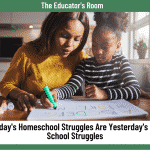Teachers who are Parents: When we were first placed on distance learning back in March of 2020, I remember thinking how privileged I was to have a son who could still attend childcare. I listened to my colleagues who had children and thought about how difficult it would be to try and teach my students while helping my young son, who needed to be in school online at the same time. And then, the pandemic continued, and we found our little family navigating virtual kindergarten with no way to adhere to the services designated in our son’s Individualized Education Program (IEP).
We were his parents, his caregivers, his paraprofessionals, his tutors, and his advocates. We were so blessed to have an incredible kindergarten teacher and an accommodating school, but many teacher-parents were not so fortunate. Whether the shift to distant learning, a school’s class or bell schedule, faculty meetings, required adjunct duties, or professional development, teacher-parents seem always to be the forgotten demographic.
“The teacher vs. parent dynamic is real for many teachers. Juggling the responsibilities of raising their own children while raising other people’s children is no easy task.”
Being a Teacher vs. a Parent: How to Strike the Right Balance at Home and School
I am a mother first and have been for nearly seven years. Be that as it may, I have spent over twenty years in education “mothering” thousands of students. I am finding it more and more challenging to navigate these two worlds without feeling like I am somehow failing to do my best in both. For example, when our school was voting on a class schedule, I wanted to ensure I was considering the needs of students and making sure I was able to pick up my son from school. Not everyone had such wonderfully supportive and flexible administrators who were willing to work with a parent-teachers child’s schedule, and for that, I am eternally grateful. But, when district offices make different school and bell schedules for elementary, middle, and high schools, do they ever think about teacher-parents and how they might handle three different schedules?
I know firsthand many teacher-parents who have children in all three levels of education. Further, not all parents feel comfortable putting their children in after-school programs, especially parents of children with special needs. Not all teacher-parents have trusted family members or friends that can pick up their children and possibly even keep them until their schools let out for the day. And not all teacher-parents have the financial means to pay for after-school childcare or tutoring. Considering the teacher-parent demographic during decision-making is often non-existent.
“About half — 48% — of all public school teachers have children living at home, according to an analysis by the Brookings Institution’s Michael Hansen and Diana Quintero. This includes young children, who need constant supervision…” .
Hansen, M., Quintero, D. (2018). The Growing Need for Diverse Teachers in the Mountain West. 1-18.
When we went on long-term distance learning, I had to work out a schedule where I could navigate my students’ and son’s education, often feeling an imbalance of effectiveness in either realm. I was so blessed to have a kindergarten teacher who was a mother herself and who was also navigating teaching and helping her young children with their education. I underestimated the time, effort, and energy it took to help my son complete homework while having to lesson plan and grade for my classroom. I found myself questioning how long I could sustain such a seemingly impossible schedule. There were many times when my son would be climbing all over me, playing with toys loudly, or on ABCMouse.com on his tablet in the same room. Of course, my students loved it so much that they asked where he was when he was not in the Zoom room. It was chaos.
And so here we are, still in the midst of a pandemic, in a system of education that is holding on so desperately to in-person learning, dealing with quarantines, temporary shifts to distant learning, and overall uncertainty that is our new normal.
- My question to the powers that be who are making plans, rules, and regulations that affect students, parents, and the community, is where do the needs of the teacher-parent demographic lie in your decision-making process?
- Do you expect us to continue to neglect our own families in an effort to maintain our status quo in education?
- While you consider how things affect the student’s and parents’ families, do you ever think about teacher-parent families?
So, what are my suggestions to make teachers who are parents feel seen and heard? First, when you make a schedule, consider all parties affected, all levels of schooling, and maybe even look at all schedules before deciding on a school schedule. When you set a mandatory meeting, use what we have learned in this pandemic and provide permanent virtual options so that teacher-parents can be involved and included. When you mandate professional development, provide a substitute and complete it during school hours. When you require adjunct activities, ok? How about eliminating that mandate if a teacher has a child in the school system?
We have given thousands more hours to teaching than the allotted six hours in the classroom. And while we are at it, when you are reimagining the future of education, think about teacher-parents, or better yet, ask us what might work. Ask a teacher who just so happens to be a parent what might work for both parents and teachers. Fancy that.






I hear you. This is tough, and it’s a shame that so many districts are making decisions to appease their political constituents instead of considering the wellbeing of all of their stakeholders (including the employees). Thank you for bringing light to this.
For instance, my son’s school just abruptly announced a 3-day switch to virtual learning and his daycare said they wouldn’t allow students from his school to be there for any part of the virtual learning days or the before/aftercare for which I must continue to pay while he’s out. I teach at a different school in the same district, but teachers are NOT ALLOWED to use sick leave (just personal days or UNPAID leave) if we need to take care of our child due to school closure or daycare closure. As a teacher and single mother, this is particularly challenging for me. Fortunately, I was able to find friends who could help me out for these few days, but this scenario shouldn’t be my reality or anyone else’s.
Districts demonstrated that they could be flexible when necessary (hello virtual learning during the 2020-2021 school year!) but it is apparent that they choose to be flexible only when it suits their own needs and not when it comes to doing what is actually best for their teachers and students.
Thank you for this post. Do you have the citation for the quote, “about half — 48% — of all public school teachers have children living at home, according to an analysis by the brookings institution’s michael hansen and diana quintero. this includes young children, who need constant supervision…”?